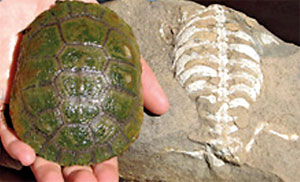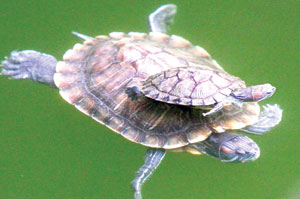Why Turtles Have Shells
View(s):No other animal has a shell quite like a turtle’s. Biologists, or scientists who study living things, have spent nearly two centuries trying to understand how turtles ended up with their unique shells. Now, thanks to the discovery of the turtle’s earliest known ancestor, scientists have found a big clue in the mystery of the turtle’s shell.

Eunotosaurus africanus, one of the turtle’s earliest-known ancestors, lived more than 260 million years ago.
The shell of a turtle grows from bone. That’s different from other animals with protective armour, like armadillos. Armadillos are mammals that have thick scales that look like shells. In fact, an armadillo’s covering is more similar to that of crocodiles than to that of turtles. And while the shells of crabs and lobsters are shed and regrown over the years, turtles keep theirs for life.
For years, the oldest known turtle fossil was from a species called Odontochelys semitestacea. It lived about 220 million years ago. Its shell looks very similar to that of today’s turtles. But how did this complicated feature evolve, or develop over a long time? Scientists were curious about how turtles were related to even more ancient reptiles.
Now perhaps they have found a “missing link”. Older fossils have been found recently from a creature known as Eunotosaurus africanus. Found in South Africa, these bones are about 40 million years older than those of Odontochelys. “Now we’ve got an intermediate shell, a transitional form that bridges the gap between turtles and other reptiles and helps explain how the turtle shell evolved,” says Tyler Lyson, a Yale University scientist.
Secrets of the Shell
A turtle’s shell may look like one big backpack. But it’s actually made up of about 50 separate bones. Before the recent fossil discoveries, scientists thought that reptile shells evolved from scales. Lyson thinks that turtles’ shells evolved from ribs.
This is not an easy evolutionary step. Ribs typically allow animals to breathe easily. But imagine how much harder it would be to breathe if you had a thick shell around your stomach!

Turtle shells are made up of about 50 separate bones.
That difficulty could be why no other animals evolved to have the same kind of shell as a turtle. “If you incorporate your ribs into a protective shell,” says Lyson, “then you have to find a new way to breathe.”
Turtles and other shelled creatures use shells like shields to protect themselves from predators, or animals that hunt them.
Turtles probably needed a shield on their backs and stomachs because they faced predators in the ocean from both above and below.
Lyson hopes to study how turtles’ breathing evolved to work best with their special shells.
Scholastic News
Follow @timesonlinelk
comments powered by Disqus


